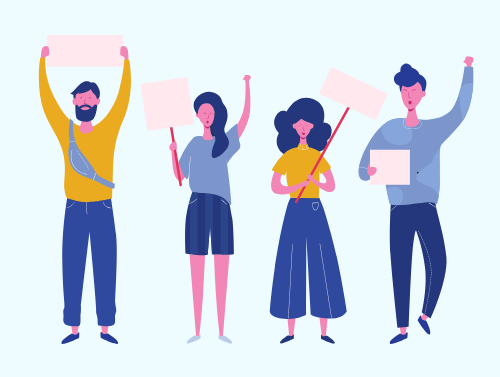Why we should look to International Development to reclaim International Women’s Day (IWD) Part II
Exactly this time last year, I wrote a small piece about why we must look to key tools and theories frequently deployed in international development, such as intersectional feminism, to enhance International Women’s Day moving forward.
I wrote the piece following the markedly different interpretation and feel towards IWD in 2023. It was clear that for many women the cupcake was no longer going to cut it. The women asked to chair, speak at or run IWD events highlighted how this actually constitutes additional work, often on top of caring duties and career obligations. Fck the Cupcakes: why aren’t there as many men attending IWD events? Others argued that IWD has become overly corporatised and is an opportunity for organisations to virtue signal their progressiveness without accountability. IWD also brought to attention issues such as reproductive rights, and violence and abuse against women.1 in 5 Australian women have experienced sexual violence.

Source: theluxuryspot
The primary issue that my piece engaged with, however, was the idea that IWD is increasingly less inclusive. For low-income women, who are at the coal face of the housing, healthcare and economic crisis, the focus on ‘girl bosses’ and women in corporate leadership positions was and continues to prove increasingly out-of-touch. For many First Nations women, IWD is not a day to celebrate with continued widespread incarceration rates and high levels of family or partner violence. It was in this context that I argued that for IWD to move forward meaningfully we must centre intersectionality and acknowledge that the struggle of women can look and be experienced differently depending on intersections of ethnicity, class, sexuality, and identity.
Fast forward to IWD 2024 and I had the opportunity to reiterate this point to a larger audience as I addressed my old school in Melbourne as a guest speaker. It was a privilege to delve into the relationship between international development, intersectionality and International Women’s Day (yes, I realise that is a lot of “inters”). Yet in the aftermath of IWD 2024, I had a new niggling feeling about IWD. My speech, reflecting many of the wider objectives of IWD, highlighted some of the barriers women face to women’s economic empowerment and gender equality more broadly. It also focused on the transformative impact that economically empowering women can have on women, men, communities and entire economies at large.
However, as I walked away I couldn’t help but think: my speech might have been a rallying cry for the young women in the crowd but where did the young men fit in? In particular, how was my speech, and many others on IWD, understood or perceived by young men, particularly when men and patriarchal structures are often highlighted as the culprit? And it got me thinking: how do we ensure that gender equality initiatives and events like IWD also spark interest in men, are spaces that they are likely to attend, and can meaningfully engage in? Afterall, it shouldn’t be women who are shouldered with the entire task of achieving gender equality.
And there is no simple answer to this complex question. On the one hand, we do not want to tone down IWD or women’s issues in order to make them more palatable to men. In fact, when the complexity and depth of the issues remain so clear, this simply isn’t an option. My heart aches for the 19 women already killed in Australia in 2024 according to Australian Femicide Watch. But on the other hand, when we don’t meaningfully and actively engage young men on days like IWD then we may risk IWD being (mis)interpreted as a day that is not about gender equality for all but instead alienates young (and older) men. Indeed, consider this recent, incisive report in The Economist that outlines the increasingly polarised views of young men and women globally. Worryingly, young men in Europe are now more anti-feminist than older men and perceive educated women as a threat to men’s access to good jobs. These findings contradict the popular notion that each generation is more liberal than the previous one. The report also draws upon Richard Reeve’s “Of Boys and Men” that explains that when young men interpret feminism and gender equality as suggesting there is something intrinsically wrong with men then it sends them to the online manosphere where anti-feminist positions are fostered. Some of this data may well underpin why male IWD attendance is low.
Therefore, it is in this critical context that I urge for a second return to theories and tools innovatively deployed in international development to enhance IWD once again. In particular, I want to highlight two international development organisations that are working to nip gender inequality in the bud. They work hard to make gender equality a-whole-of-community endeavour, to highlight how gender norms can be damaging to both men and women, and to engage young and old men in meaningful ways to become allies.
First, consider the Grass Skirt Project (GSP) in Papua New Guinea (PNG). Founded by Tahina Booth, GSP tackles severe gender inequality and violence against women and girls in PNG by uniting sport and gender justice. For Tahina, sexual and domestic violence against young women and girls in the Pacific is a key development priority to achieve healthy and happy communities. However, the core ethos at GSP is that sexual and domestic violence against women is not a problem to be solved just by women and girls. Instead, GSP sees engaging young men and boys as key to the solution and imperative to fostering a more inclusive and equitable PNG more broadly.
Consequently, GSP’s programs, including the Gymbox and 10 Million Strong Leadership program, empower youth of all genders to challenge norms and embrace equity. They are designed to engage men and boys with something they love, sport and fitness, to ultimately heighten gender justice awareness and reduce gender-based violence. Moreover, by providing access to gym facilities and health resources for underserved communities, the programs are also achieving broader goals in the community related to holistic health, education and economic uplift.
Second, let’s talk about Dandelion Africa in Kenya. Founded by Wendo Aszed, Dandelion Africa is a women-led NGO focused on women’s health and economic empowerment in the rural areas of Nakuru, Baringo, Kajiado and Narok counties. Critically, amongst a number of impactful initiatives such as “Girls for Leaders”, Women’s Livelihoods and Sexual Reproductive Health programs, they also coordinate “Boys for Change”. Boys for Change works with over 5000 boys and men through engagement in advancing gender equity and equality. The Dandelion Africa team believe that the program is necessary not only for the empowerment of women and girls, but also to transform the social and gender norms that reinforce patriarchy. The Boys for Change are trained on Menstrual Hygiene and information to champion and eradicate Female Genital Cutting (FGC).

Boys For Change. Source: Dandelion Africa
Gender equality is for all. And it is organisations like Grass Skirts Project and Dandelion Africa that inspire me to work in the ID sector everyday.
Both Grass Skirt Project and Dandelion Africa have been featured on AIDN’s podcast Philanthropod here.
———————————–

Hannah McNicol
Hannah is the Communications and Research Lead at the Australian International Development Network (AIDN). She is also a Cookson Scholar and International Development PhD Candidate at the University of Melbourne and University of Manchester, and an affiliate of the Global Development Institute. After completing a Masters of Development Studies (specialising in gender theory), Hannah worked at Good Return (an Australian NFP focusing on women’s economic empowerment across the Asia-Pacific) and the Australian Red Cross.
Feature image: Canva
